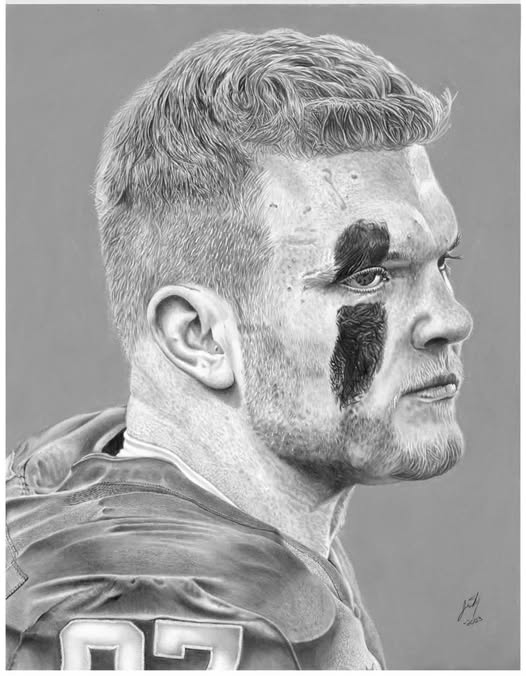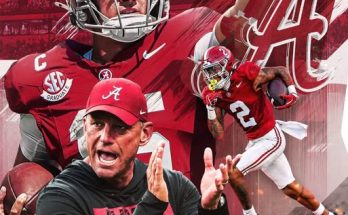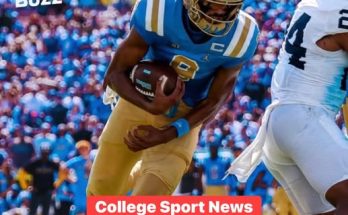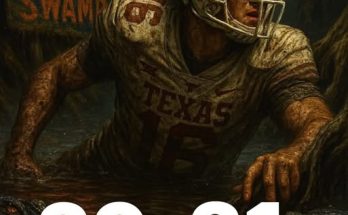This is a pencil drawing I completed of Aidan Hutchinson back in 2023. At the time, I wasn’t sure what the final product would look like or how it would be received, but I knew that I was inspired. Something about Hutchinson—the way he carries himself on and off the field, the emotion he pours into every play, and the story that brought him to the NFL—compelled me to pick up a pencil and begin sketching. It wasn’t just a portrait I wanted to create; it was a tribute.
Pencil drawing has always been a medium that I’ve connected with on a deep level. There’s something about its simplicity—the raw contrast between light and dark, the texture that emerges from thousands of tiny strokes, the ability to erase, refine, and build up layers slowly—that appeals to my sense of patience and precision. For this piece, I used a range of graphite pencils, from 4H for the lightest shades and outlines to 8B for the deepest shadows. Every pencil served a specific purpose, and every line had its place.
When I first decided to draw Aidan Hutchinson, I spent a good deal of time selecting the reference image. I didn’t want just any photo—I needed one that captured his intensity, his personality, and something beyond the surface. I eventually found an image that hit all the right notes: Hutchinson in the middle of a game, helmet off, sweat beading on his forehead, and a look of deep focus and grit in his eyes. The background was blurred, but his presence was striking. That moment felt like him—not just the player, but the person.
I began the drawing the same way I usually do—with the eyes. For me, the eyes are the soul of a portrait. If you can capture someone’s gaze just right, the rest of the drawing almost falls into place. Hutchinson’s eyes carry a kind of fire—a mixture of determination and calm, like someone who understands what’s at stake but never lets it overwhelm him. Getting the light reflections just right in his pupils was one of the most challenging parts of the piece. It required layering very soft graphite and using a kneaded eraser to pull out subtle highlights. But once the eyes were complete, I felt like I could already see him coming to life on the paper.
From there, I worked outward—nose, mouth, jawline. His facial structure is strong, well-defined, and, artistically speaking, satisfying to draw. His jaw is square, his cheekbones high, and his expression serious but not severe. These features demanded careful shading to make them feel three-dimensional. I used cross-hatching techniques to build up volume, going slow to keep every stroke deliberate. The challenge was not to overwork it. With graphite, too much pressure can flatten the texture or give it an unnatural sheen. I often found myself stepping away from the drawing, holding it at arm’s length, trying to evaluate the contrast and composition with fresh eyes.
Drawing the hair and helmet posed another unique challenge. Hair is all about flow and light—it’s less about individual strands and more about capturing movement and volume. Hutchinson’s hair, tousled and damp from exertion, needed to look dynamic yet grounded. I used a combination of HB and 2B pencils to create the hair’s lighter tones and depth, using short directional strokes and blending with a tortillon for softness. His helmet, resting at an angle in the original photo, offered a nice contrast with its smooth metallic texture. Rendering that required a totally different approach—more rigid outlines, hard shadows, and sharp highlights.
One of the most gratifying aspects of this drawing was the jersey. It’s easy to overlook the importance of clothing in a portrait, but for athletes, the uniform is part of their identity. Hutchinson’s Detroit Lions jersey carries symbolism: grit, resilience, team pride, and legacy. I wanted the jersey to feel weighty and tactile, so I focused on the folds of the fabric, the stretch of the material across his shoulders, and the way light and shadow defined each crease. The mesh texture took time—dot by dot, stroke by stroke—but it was worth it for the realism it added.
The background of the drawing I kept minimal. There was enough detail in the figure itself, and I wanted the viewer’s focus to remain on Hutchinson. Instead of filling the entire page, I let the white of the paper provide negative space, which framed the figure like a spotlight. I lightly suggested a bit of crowd noise in the blurred background, just enough to give context without distracting from the subject. Sometimes less is more, and I believe that held true here.
But beyond the technical elements, this drawing was about connection. I didn’t set out to just recreate a photograph—I wanted to reinterpret it through my hands and eyes, to show something about who Hutchinson is, or at least how I perceive him. Art allows for that kind of emotional translation. It’s not just about what you see, but how you feel about what you see. In Hutchinson’s case, I saw a rising star, a young man bearing the weight of expectation and responsibility, and doing so with humility and intensity. Capturing that essence was my true goal.
The piece took me over 30 hours spread across several weeks. I worked in sessions of two to three hours at a time, mostly at night when the world was quiet and I could concentrate without interruption. Each session brought me a little closer to completion and deeper into the creative process. There were moments of frustration—when shadows didn’t sit right, or when proportions felt slightly off—but also moments of surprising clarity, when a small detail like a highlight on the cheek suddenly made everything click.
When I finally put the pencils down and declared the drawing finished, I felt a strange mix of relief and detachment. That always happens to me. It’s as if the drawing no longer belongs to me once it’s complete—it becomes something separate, with its own presence and energy. I posted it online a few days later, and the response was overwhelming. Friends, family, and even strangers commented on the likeness, the emotion, the craftsmanship. Some thought it was a photograph at first glance, which was the highest compliment I could receive. But more importantly, people said they felt something when they looked at it—and that, for me, was the real victory.
Looking back, this drawing marked a turning point in how I viewed my art. It wasn’t just about skill anymore—it was about voice. Every line I drew was a way of saying something about the subject, about my perspective, and about what matters to me. And in 2023, that subject was Aidan Hutchinson—a symbol of athletic excellence, personal growth, and a deep, authentic drive that many people admire.
Since then, I’ve completed other works, some of athletes, some of everyday people. But the Hutchinson drawing remains a favorite. Not just for how it turned out, but for what it taught me. It reminded me that art is a journey—not just from blank page to finished image, but from observation to understanding. It also reminded me of the importance of staying inspired, of choosing subjects that stir something in you.
I don’t know if Aidan Hutchinson will ever see the drawing, but I hope that if he does, he recognizes the respect and admiration behind it. More than a portrait, it was a way for me to say: I see you—not just your stats or highlight reels, but your effort, your passion, your humanity. That’s what great art does—it bridges the gap between viewer and subject, between artist and world.
And that’s what I tried to do with this pencil drawing, back in 2023.



